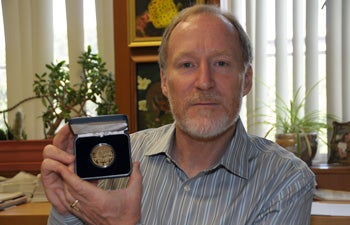Curtailing Poisonous Shellfish
The National Oceanic and Atmospheric Administration (NOAA) has granted $4 million to a team including USC scientists for a five-year project to investigate early detection of potentially deadly algal blooms — known as red tides — in coastal California.
The research is meant to protect public and animal health in coastal California. Some species of red tides produce a toxin eaten by shellfish that when humans consume can lead to fatal illness. The toxins can also cause illness and death in marine mammals and birds. This project will allow scientists to detect and measure levels of some toxic cells in water samples, providing officials with an early warning of algal blooms that can lead to poisonous shellfish. The research will also address whether nutrient pollution from the land enhances toxic algal blooms.
USC Dornsife’s David Caron and Burt Jones, professors of biological sciences, and Gaurav Sukhatme of the USC Viterbi School of Engineering, will conduct the research with the University of California, Santa Cruz; Moss Landing Marine Laboratories; Monterey Bay Aquarium Research Institute; the Southern California Coastal Water Research Project; UCLA and NOAA.
“This project will allow the continuation of a decade of observation by our research group of toxic algal blooms in the coastal ocean of southern California,” Caron said. “It will also enable a comparative study of algal blooms of central California, in cooperation with several research groups in the Monterey Bay region, that should help identify specific environmental factors that lead to harmful events.”
The teams will detect and monitor toxic blooms with equipment that can forecast ocean conditions, potentially leading to harmful bloom predictions.
“Improving our understanding of the environmental conditions that are conducive to a toxic bloom would help focus our sampling effort so we can alert the public to dangerous toxin levels in seafood,” said Gregg Langlois, senior environmental scientist at the California Department of Public Health.

USC Dornsife’s David Caron (pictured here) and Burt Jones, professors of biological sciences, and Gaurav Sukhatme of the USC Viterbi School of Engineering, make up the USC team that received a $4 million grant from the National Oceanic and Atmospheric Administration (NOAA) to investigate dangerous algal blooms. Here, Caron holds up a medal he received from the city of Redondo Beach for his algal bloom research. Photo by Pamela J. Johnson.
Since 2003, the San Pedro shelf region has become a site of recurring, and increasingly severe, wildlife intoxication hotspots in California. Caron and his researchers have been studying that region since 2005, when a fish die-off occurred in King Harbor at Redondo Beach. In 2006, they began taking weekly water samples and the next year, installed sensors at the harbor that measure in part the temperature, salinity, chlorophyll and plant pigment in the water. The sensors record the measurements every half hour, detecting any algal blooms and toxic algae that may be present. This new grant will step up this research.
During the first year of the grant, the USC team will establish parameters in the water and test models of harmful algal bloom predictions. USC researchers will investigate the location and depth of harmful algal bloom development in the San Pedro shelf region and the factors leading to algal toxins. They will collaborate with the central California team on field studies for years 2, 3 and 4. Their strategies include designing, constructing and implementing a system that will capture data.
During years 2, 3 and 4, the USC team’s major fieldwork will focus on characterizing the spring blooms in the San Pedro shelf region. Underwater gliders will be deployed to collect samplings.
For year 5, the field-based experimental studies will be terminated and the emphasis will turn to data summary, examining results and comparing findings with Monterey Bay and the other regions. All team members will evaluate their hypotheses and begin writing their final manuscripts.